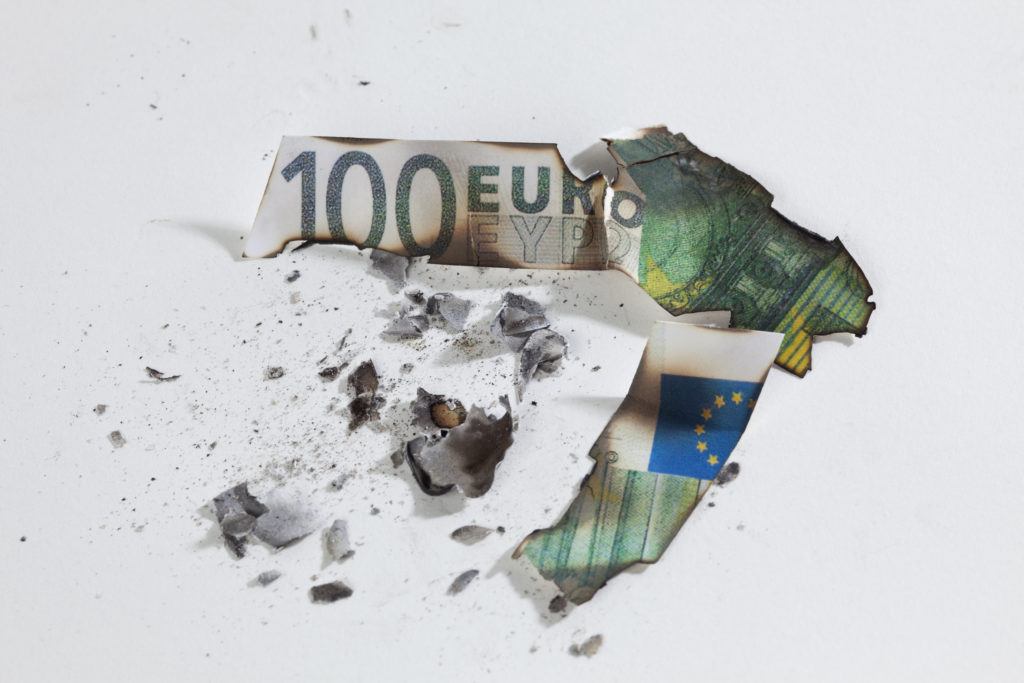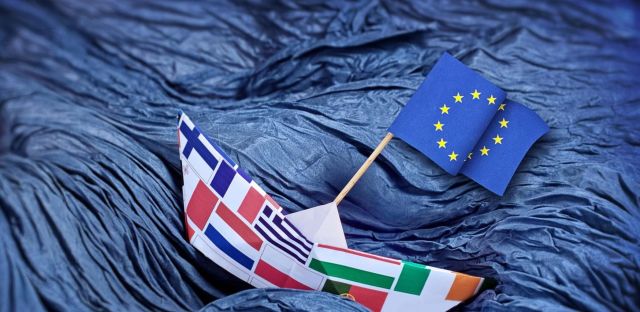Credit: Getty

There is every chance, when the official figures are published (and then, inevitably, revised), that the eurozone will register faster growth during 2017 than the UK.
The 19-nation currency bloc expanded 2.5% year-on-year during the third quarter of 2017 – compared to 1.8% in the UK. Moreover, survey data from December shows the eurozone’s Purchasing Managers’ Index registering 58.1 (where 50 and above indicates growth) compared to Britain’s more modest 54.9.
These growth numbers have been gleefully circulated by those determined to block Brexit – as ‘evidence’ the UK is doomed to under-perform over the coming years. They’ve also led some to conclude the eurozone no longer faces systemic dangers. Neither proposition is true and, as such, it is important to put these eurozone growth numbers in their medium-term context.
I’m delighted the eurozone is growing. The EU accounts for around 40% of UK exports – and will remain a major market for us after Brexit. A healthy, fast-expanding eurozone is good for Britain, too. Yet this latest growth, after years of eurozone stagnation, in no way amounts to an economic renaissance. Nor does it solve the major structural issues at the heart of the single currency and the broader EU.
One reason the eurozone is growing faster than the UK is that it’s recovering from a decade of significant under-performance. Since the 2008 financial crisis, while GDP in the UK and US has expanded on average by 1.5% and 1.2% respectively per year, the eurozone has managed just 0.4% annual average growth. As such, it took the eurozone eight years to recover from the 2008 financial crisis, something the UK achieved in half the time.
Growth across the eurozone is also very uneven:
- While Germany managed annual average growth of 1.1% during the ten years since the financial crisis…
- Spain has expanded by just 0.1% each year…
- Italy has actually contracted, by an average of 0.5% per annum, since 2008.
Some eurozone nations, then, find life in the single currency straitjacket so tough that their GDP has still not reached pre-crisis levels. Italy, in fact, has barely grown since the euro was launched in 1999.
Along with large growth disparities, eurozone unemployment remains at almost 9% – twice as high as Britain’s 4.2% rate. Monetary union has worked well for Germany, Netherlands and other wealthy northern members, their exporters benefiting from a currency far lower than their economies would warrant alone. Yet it has throttled other Mediterranean nations, as they’ve laboured under a single currency which, for them, has long been significantly over-valued. That helps explain youth unemployment of no less than 40% in Spain and Italy and 50% in Greece – figures that amount to nothing less than a generational tragedy.
Flawed at birth
The single currency was “flawed at birth,” according to Nobel Laureate economist Joseph Stiglitz, despite being an avowed and long-standing supporter of the EU. “The structure of the euro is to blame for the poor performance of Europe, its successive crises and increased inequality,” he says[1. Stiglitz, Joseph, “The Euro”, Allen Lane, 2016]

Far from promoting European prosperity and peace, the euro has “tied together” countries with vastly different economic and social backgrounds, Stiglitz concludes, “denying them the vital ability to manipulate their exchange and interest rates”. Former Greek Finance Minister Yanis Varoufakis, who battled with Brussels during the early stages of his country’s on-going bailout negotiations, is even more direct. The single currency has “sown division across Europe,” he says, “turning Europeans against Europeans”[2. “After Brexit: The battle for Europe”, BBC4 television documentary, 14.02.17. At the time of writing, this documentary has unfortunately been removed from BBC iPlayer.].
Extremely uneven, and partly driven by “catch-up”, the eurozone growth we’ve seen in 2017 has also been heavily dependent on quantitative easing. The European Central Bank continues to expand its balance sheet by tens of billions of euros a month. The Frankfurt-based bank has now done more QE since 2008 than America’s Federal Reserve. Once the ECB’s money-printing stops, though, eurozone bond markets, having almost imploded in both 2011 and 2012, may well face renewed crisis.
What is certain is that if the single currency is to survive in the long-run, member states must secure both a fiscal union and a banking union – pooling government revenues to a far greater extent and putting their respective sovereign balance sheets behind each others’ banking sectors.
Some say that the election of Emmanuel Macron in France means such big advances in “Project Europe” are now likely. The German electorate seems to think otherwise. It may be that the eurozone’s paymaster – which will be the only major, consistent net contributor to the EU budget once Britain has left – can be convinced to bankroll the rest of the eurozone and the broader EU. But I somehow doubt it.
Berlin rhetorically backs “Europe” and has spent tens of billions of euros on bailouts. Yet Der Spiegel dubs Macron “Teurer Freund” – our ‘expensive friend’. [3. Der Spiegel, 15.05.17, ‘Frenemy in the Making? Merkel Views Macron with Skepticism and Hope’.]
Chancellor Angela Merkel has long been entirely against a unified Eurozone finance ministry, with explicit fiscal pooling and mutually guaranteed banking sectors. And the German electorate remains extremely unlikely to accept the kind of deep fiscal integration that is ultimately required to guarantee the euro’s survival.
That has been the case for many years –and looks even more certain since elections last September, which saw the recently-formed hard-right eurosceptic party Alternative Fur Deutschland come third, with no less than 13% of the vote.
For all the displays of unity, France and Germany are irrevocably split on the future of Europe. Traditionally obedient Europhile nations like Finland and the Netherlands are meanwhile complaining loudly about bailouts and QE, their electorates also increasingly backing Eurosceptic candidates. Populations across the Mediterranean are also far less enamored with the EU than they once were. And new members in Eastern Europe, particularly Hungary and Poland, are now also openly chiding Brussels – cheered on by their increasingly Eurosceptic electorates.
More than three months on from an election, Merkel is still trying to form a government. A combination of ECB money-printing and endless bailouts, as well as the disproportionate burden Germany shouldered during the EU’s migrant crisis, has angered voters. For the first time since World War Two, Merkel’s CDU and the centre-left SPD failed, between them, to command a majority of votes cast – an electoral watershed. Yet German voters are now about to be presented with yet another ‘Grand Coalition’ of these two mainstream parties – a development that could fuel further support for AfD and other radical parties.
I will be accused of unfairness, but I genuinely believe the eurozone, and perhaps even the EU, could be just one bad election, one geopolitical event, one eurozone bond crisis away from a great unraveling. I’m far from alone in that view. “I know about the state of the EU,” said Sigmar Gabriel in January 2017, who has since become Germany’s Foreign Minister. “It is no longer unthinkable that it breaks apart”[4. Reuters, 07.01.17, “Germany’s Gabriel says EU break-up no longer unthinkable” ].
And it strikes me that the main danger the EU faces this year is Italy.
Mamma Mia!
Having been hit by the extended, decade-long slump, the eurozone’s banking sector remains weighed down by bad debts. Non-performing loans amounted to €866 billion as of December 2016 – representing 6.4% of gross loans outstanding across the eurozone, well above the UK (1%) and the US (1.5%) where banks have raised more capital since the global financial crisis and acknowledged more write-offs. High NPLs have kept fresh eurozone bank lending subdued, stymying job creation and growth.
While Germany has an NPL ratio of 3.2%, the figure in Italy is a massive 17pc, with bad bank loans amounting to €360 billion – up 80% since 2010. This is a major reason why eurozone fiscal pooling and banking union won’t happen. Economic stagnation and high unemployment has seen Italy’s national debt spiral to over 130% of GDP – much of it held by the nation’s banks. This loan-pile represents “a major source of vulnerability” for the single currency, observed the European Commission in February 2017. In response, Rome says the Commission and other EU member states should cut Italy “more slack”, not least as the country has also been heavily affected by the migrant crisis.
Italians refer to NPLs as le sofferenze – the suffering. The stock of bad loans is now so large that on-going slow growth means the chances of a natural banking recovery look remote. The Italian economy is ten times bigger than Greece – a systemic Italian bond crisis would shake the global financial system to its foundations. Consider also that the 2007 sub-prime debacle was originally triggered by the accumulation of bad housing loans that generated a 5% NPL ratio among US banks. The bad loan share across Italian banks is more than three times larger.

Ahead of elections this coming March, Italy’s three main opposition parties – including the Five Star Movement, headed by comedian turned political leader Beppe Grillo – have all supported leaving the euro, which they believe is preventing economic growth. At the time of writing, Five Star is polling at around 30%, well ahead of any other party.
Victory for Grillo’s party, even if Five Star were unlikely to take office, could spark another systemic crisis across the eurozone. This election in March represents the biggest flashpoint for the EU economy since the eurozone bond crisis of 2012, with Italy potentially emerging as the epicentre of global instability.
Last year, right-wing firebrands in both Holland and France, campaigning on an anti-Brussels platform, significantly increased their vote shares. Austria and Germany also lurched rightward. Now, with Italian elections fast-approaching, the populist, anti-EU Five Star Movement, looks set to come first.
The UK economy, while bearing up well, faces considerable uncertainties in 2018 – relating to housing, productivity, inflation and, of course, our on-going Brexit negotiations. It may be, though, that the uncertainties facing the eurozone are greater still.










Join the discussion
Join like minded readers that support our journalism by becoming a paid subscriber
To join the discussion in the comments, become a paid subscriber.
Join like minded readers that support our journalism, read unlimited articles and enjoy other subscriber-only benefits.
Subscribe